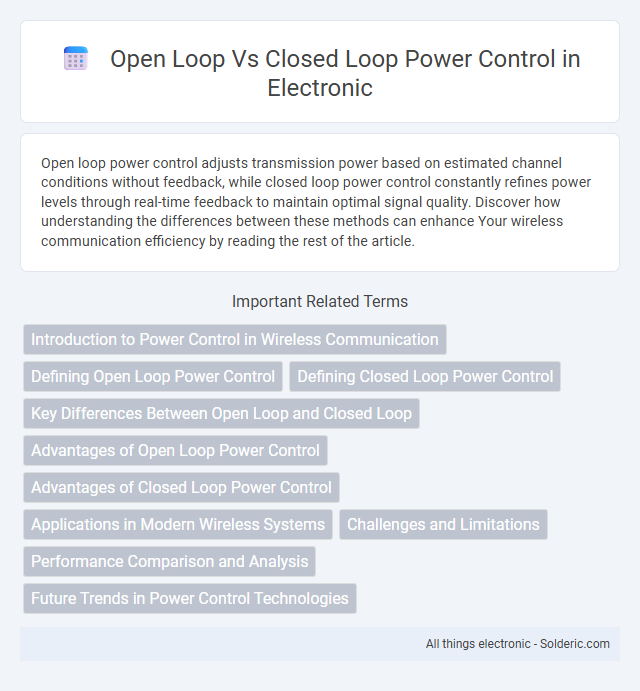Open loop power control adjusts transmission power based on estimated channel conditions without feedback, while closed loop power control constantly refines power levels through real-time feedback to maintain optimal signal quality. Discover how understanding the differences between these methods can enhance Your wireless communication efficiency by reading the rest of the article.
Comparison Table
| Feature | Open Loop Power Control | Closed Loop Power Control |
|---|---|---|
| Definition | Power adjustment based on predefined parameters without feedback. | Power adjustment using real-time feedback from the receiver. |
| Feedback Mechanism | No feedback from receiver. | Continuous feedback to adjust transmit power. |
| Accuracy | Less accurate; prone to signal distortion and inefficiency. | Highly accurate; maintains signal quality and minimizes interference. |
| Complexity | Simple implementation. | More complex due to feedback processing. |
| Use Cases | Initial power setting, low complexity systems. | Dynamic environments, LTE, 5G networks. |
| Power Efficiency | Lower efficiency; may cause higher interference. | Optimized efficiency; reduces interference and power waste. |
| Response Time | Faster as no feedback loop. | May experience slight delay due to feedback analysis. |
Introduction to Power Control in Wireless Communication
Power control in wireless communication optimizes signal strength to maintain reliable connections while minimizing interference and energy consumption. Open loop power control adjusts transmission power based on initial signal estimates without feedback, making it faster but less accurate. Closed loop power control continuously monitors and adjusts power using real-time feedback from the receiver, ensuring better link quality and efficient resource use.
Defining Open Loop Power Control
Open Loop Power Control is a method used in wireless communication systems to adjust the transmission power based on predefined parameters without feedback from the receiver. This technique relies on factors such as path loss estimation and the mobile device's own measurements to set the initial power level, ensuring basic link quality. Open Loop Power Control is simpler but less accurate compared to Closed Loop Power Control, which dynamically adjusts power using real-time feedback.
Defining Closed Loop Power Control
Closed loop power control continuously adjusts the transmit power based on real-time feedback from the receiver, optimizing signal quality and minimizing interference in wireless communication systems. It relies on measurement reports and control commands transmitted between the base station and the mobile device to maintain desired signal levels. Closed loop power control enhances system capacity and user experience by dynamically balancing power output to adapt to changing channel conditions.
Key Differences Between Open Loop and Closed Loop
Open Loop Power Control relies on preset power levels without feedback, making it simpler but less adaptive to changing channel conditions. Closed Loop Power Control continuously adjusts transmission power based on real-time feedback from the receiver, enhancing signal quality and reducing interference. Your choice between open loop and closed loop affects system responsiveness, accuracy, and overall network performance.
Advantages of Open Loop Power Control
Open loop power control offers simplicity and low latency by adjusting transmission power based on predefined parameters without relying on feedback from the receiver. This method reduces system complexity and is beneficial in fast-moving environments where rapid adjustments are necessary to maintain link quality. Its independence from real-time feedback lowers signaling overhead, making it suitable for scenarios with limited communication resources.
Advantages of Closed Loop Power Control
Closed Loop Power Control offers superior accuracy in maintaining optimal transmission power by continuously adjusting based on real-time feedback from the receiver, reducing interference and improving signal quality. This dynamic adjustment enhances system capacity, battery life, and overall network performance compared to Open Loop methods. Closed Loop systems also adapt efficiently to varying channel conditions, ensuring reliable connectivity in diverse wireless communication environments.
Applications in Modern Wireless Systems
Open loop power control is widely used in initial access and handover procedures in LTE and 5G networks due to its low complexity and rapid response. Closed loop power control enhances link reliability and interference management in CDMA and massive MIMO systems by dynamically adjusting transmit power based on real-time feedback. Combining both control schemes optimizes spectral efficiency and user experience in heterogeneous network environments.
Challenges and Limitations
Open Loop Power Control faces challenges such as lack of real-time feedback, leading to potential inaccuracies in power adjustments due to varying channel conditions and interference. Closed Loop Power Control, while more adaptive through continuous feedback, encounters limitations like increased complexity, latency, and sensitivity to feedback errors that can degrade system stability. Your choice between these methods impacts network performance, requiring a balance between responsiveness and control accuracy.
Performance Comparison and Analysis
Closed loop power control offers superior performance over open loop by continuously adjusting transmit power based on real-time feedback from the receiver, resulting in improved signal quality and reduced interference in wireless communication systems. Open loop power control relies on preset parameters without feedback, leading to less accurate power adjustments and potentially higher error rates in fluctuating environments. Analysis shows closed loop mechanisms enhance system capacity and battery life due to precise power regulation aligned with dynamic channel conditions.
Future Trends in Power Control Technologies
Future trends in power control technologies emphasize integrating adaptive algorithms and machine learning to enhance precision in both open loop and closed loop systems. Innovations in real-time data analytics and sensor fusion improve feedback mechanisms, reducing latency and optimizing power efficiency in wireless communication networks. The evolution toward intelligent, self-optimizing power control solutions aims to support 5G and beyond, enabling dynamic resource allocation and minimizing interference in complex environments.
Open Loop vs Closed Loop Power Control Infographic

 solderic.com
solderic.com